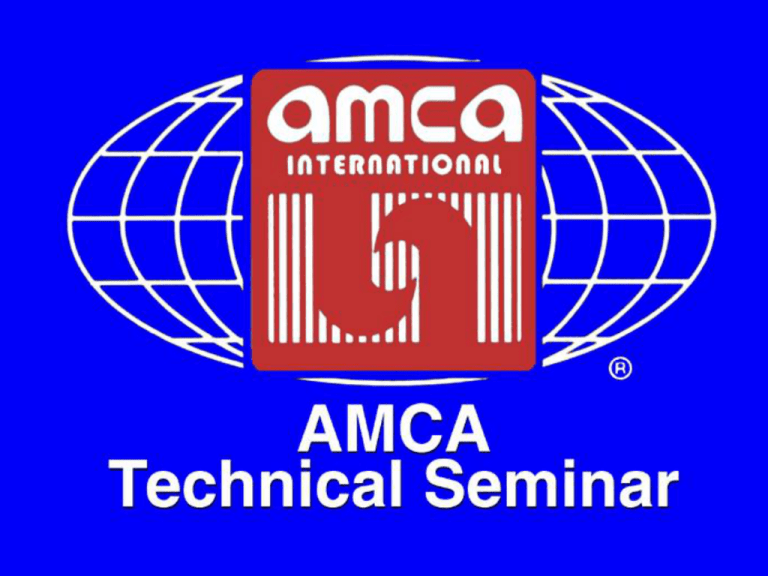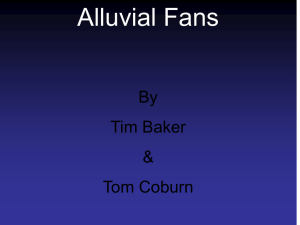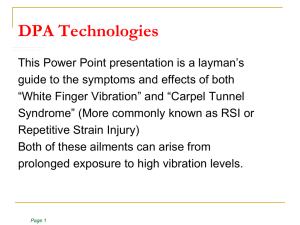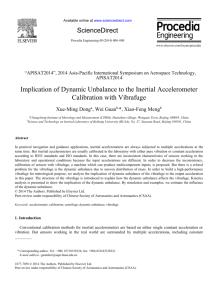Equipment Vibration - Air Movement and Control Association
advertisement

AMCA International Technical Seminar 2009 Equipment Vibration Presented by: Bill Howarth, Illinois Blower Inc. The Air Movement and Control Association International (AMCA), has met the standards and requirements of the Registered Continuing Education Providers Program. Credit earned on completion of this program will be reported to the RCEPP. A certificate of completion will be issued to each participant. As such, it does not include content that may be deemed or construed to be an approval or endorsement by NCEES or RCEPP. Learning Objectives • • • • • • Describe the distinction between balance and vibration Know the levels of balance quality Know the levels of installed vibration Understand the importance of an adequate foundation Recognize symptoms and causes of problems Know how to avoid vibration problems Equipment Vibration Presented by Bill Howarth Hartzell Fan, Inc. ANSI / AMCA 204-96 Balance Quality and Vibration Levels for Fans • Balance • Vibration BALANCE Balance • Synonymous with Unbalance. A physical property results in centrifugal force being applied to the fan impeller. • Measured as the product of unbalance mass and distance from axis of rotation (oz-in). UNBALANCE EXAMPLE: Center of Mass Shaft Axis of Rotation Fan Impeller • ROTOR WEIGHT = 300 LBS • RADIAL SEPARATION OF CENTER OF MASS FROM AXIS OF ROTATION=0.0052 INCHES • UNBALANCE =300 LBS * 16 OZ/LB *0.0052 IN. =25 OZ-IN. UNBALANCE A. Particulate builds up uniformly on the rotor. Sticky-wet particulate in gas stream Scrubber B. A piece of particulate flies off. C. Center of mass shifts so that it no longer coincides with the axis of rotation. Fan UNBALANCE Dead spot 250F at top of housing 250F Top of shaft = 188F Bottom of shaft = 187F Fan wheel weight = 8500 lbs. Differential Expansion: (188 - 187) * (6.5E-6in/in-F) * (200 in) = 0.0013 in Shaft Bows Upward! 120F 120F at bottom of housing = Displacement from axis of rotation = 0.36” Then Unbalance = (8500)*(16)*() = 49,000 oz-in 200.0013 200.0000 UNBALANCE Dust accumulation inside hollow airfoil blade. UNBALANCE Buildup of dust on the backside of backward curves blades. UNBALANCE Hub Shaft Setscrews initially hold hub tightly in position on the shaft. Setscrew tips are corroded or worn by fretting over time. This allows the hub and entire fan wheel to be displaced relative to the axis of rotation causing unbalance. Interference fit eliminates the possibility of the hub being displaced relative to the shaft in most systems. EFFECT OF TEMPERATURE CHANGE Fan impeller initially operating at 70 F. Process gas temperature increases rapidly. Fan impeller and hub heat up more quickly than the shaft. Weld Integral hub and shaft for very rapid temperature change applications. Example: Conclusion: Shaft dia. = 3.9375 in. • Initial interference fit should Hub average temp = 215 F be in excess of 0.002 inches Shaft average temp =80 F to allow for thermal expansion plus an allowance Then hub growth relative to shaft: for hub expansion due to (3.9375) * (80) * (6.5E-6) = 0.002 in. centrifugal force. Fan impeller weight = 250 lbs.. (250 lbs. x 16 oz/lb. x 0.002 inches) Resulting unbalance = 8.0 oz-inches ANSI / AMCA 204, TABLE 4-1 Table 4-1 Fan Application Categories APPLICATION EXAMPLES DRIVER POWER kW (HP) LIMITS FAN APPLICATIO N CATEGORY, BV RESIDENTIAL Ceiling fans, attic fans, window AC <= .15 (0.2) >.15 (0.2) BV-1 BV-2 HVAC & AGRICULTURAL Building ventilation and air conditioning; commercial systems <=3.7 (5.0) >3.7 (5.0) BV-2 BV-3 INDUSTRIAL PROCESS& POWER GENERATION, ETC. Baghouse, scrubber, mine, conveying, boilers, combustion air, pollution control, wind tunnels <=300 (400) >300 (400) BV-3 BV-4 TRANSPORTATION & MARINE Locomotives, trucks, automobiles <= 15 (20) > 15 (20) BV-3 BV-4 TRANSIT/TUNNEL Subway emergency ventilation, tunnel fans, garage ventilation, Tunnel Jet Fans <=75 (100) > 75 (100) ANY BV-3 BV-4 BV-4 PETROCHEMICAL PROCESS Hazardous gases, process fans. <= 37 (50) > 37(50) BV-3 BV-4 COMPUTER CHIP MANUFACTURE Clean room ANY BV-5 ANSI / AMCA 204, TABLE 5-1 Table 5-1 FAN APPLICATION CATEGORY BALANCE QUALITY GRADE FOR RIGID ROTORS/IMPELLER BV-1* G 16 BV-2 G 16 BV-3 G 6.3 BV-4 G 2.5 BV-5 G 1.0 *Note: In FAN APPLICATION CATEGORY BV-1 there may be some extremely small fan rotors weighing less than 227 grams (8 ounces). In such cases, residual unbalance may be difficult to determine accurately. The fabrication process must ensure reasonably equal weight distribution about the axis of rotation. ANSI / AMCA 204, APPENDIX C.2 VIBRATION Vibration • The alternating mechanical motion of an elastic system, components of which are amplitude, frequency and phase. • In general practice vibration values are reported as: • Displacement - mils • Velocity - inches/second • Acceleration - peak g’s VIBRATION VELOCITY 1780 RPM Uper = 12.72 oz-in Maximum Vibration (in free space) =2.5 mm/sec (or 0.10 in.sec) VIBRATION Small Diameter, Light Rotor Vibratio n Pickup Massive Bearing Housing High Stiffness Pedestal Note that the bearing housing is considerably lower than the expected vibration of the rotor in free space. SLEEVE BEARING Shaft (rotating) Bearing Housing Proximity Probe measures shaft surface movement relative to the bearing housing. Bearing Liner (static) Oil Film supports shaft EFFECT OF STRUCTURE Fan Mass Mass Cyclic Forces Fan operating speed = 1180 RPM Structural Steel acts as a spring Fn = 1200 cyc/min Flagpole acts as a spring Fn = 30 cyc/min Foundation Circus Flagpole Acrobat SOLID FOUNDATION Normal Fn = 1680 cyc/min 1.6 1.4 Operating speed (F) Vibration (in/sec) 1.2 1.0 0.8 0.6 0.10 in/sec 0.4 0.2 0.0 0 500 1000 1180 Speed (RPM) Fn >1.4 * F 1500 2000 STRUCTURAL STEEL MOUNTING 1.4 1.2 Vibration (in/sec) Normal Fn = 1200 cyc/min Operating speed (F) 1.6 0.70 in/sec 1.0 0.8 0.6 0.4 0.2 0.0 0 500 1000 1180 Speed (RPM) 1500 2000 FLEXIBLE MOUNT Expansion Joint Expansion Joint Inlet Duct Structural Steel Platform Discharge Duct Rigid Sub-Base (Often concrete filled) Spring Isolation with static deflection of 1.0 inches Fn = 187.7/1.5 =187.7 cyc/min ANSI / AMCA 204, TABLE 6-3 Table 6-3 Seismic Vibration Limits for Tests Conducted in the Factory Values shown are peak velocity, mm/s (inches/s), Filter-In, at the factory test speed. FAN APPLICATION CATEGORY RIGIDLY MOUNTED mm/s (in./s) FLEXIBLY MOUNTED mm/s (in./s) BV-1 12.7 (0.50) 15.2 (0.60) BV-2 5.1 (0.20) 7.6 (0.30) BV-3 3.8 (0.15) 5.1 (0.20) BV-4 2.5 (0.10) 3.8 (0.15) BV-5 2.0 (0.08) 2.5 (0.10) VIBRATION UNITS TRANSDUCER MOUNTING Vertical Axial Horizontal SWSI Centrifugal Fans TRANSDUCER MOUNTING Vertical Axial Horizontal DWDI Centrifugal Fans TRANSDUCER MOUNTING Vertica l Axial Horizontal Vertical Axial Fans VIBRATION SPECTRUM Velocity (In./sec.) 0.20 Filter Out Filter In 0.15 0.10 0.05 0.00 0 500 1000 1500 Speed (RPM) 2000 2500 ANSI / AMCA 204, TABLE 6-4 Table 6-4 Seismic Vibration Limits for Tests Conducted In-Situ Values shown are peak velocity, mm/s (inches/s), Filter out. Condition Fan Application Category Rigidly Mounted mm/s (in./s) Flexibly Mounted mm/s (in./s) Start-Up BV-1 BV-2 BV-3 BV-4 BV-5 14.0 (0.55) 7.6 (0.30) 6.4 (0.25) 4.1 (0.16) 2.5(0.10) 15.2 (0.60) 12.7 (0.50) 8.8 (0.35) 6.4 (0.25) 4.1 (0.16) Alarm BV-1 BV-2 BV-3 BV-4 BV-5 15.2 (0.60) 12.7 (0.50) 102 (0.40) 6.4 (0.25) 5.7(0.20) 19.1 (0.75) 19.1 (0.75) 16.5 (0.65) 10.2 (0.40) 7.6 (0.30) Shut-Down BV-1 BV-2 BV-3 BV-4 BV-5 NOTE 1 NOTE 1 12.7 (0.50) 10.2 (0.40) 7.6 (0.30) NOTE 1 NOTE 1 17.8 (0.70) 15.2 (0.60) 10.2 (0.40) Note 1: Shutdown levels for fans in Fan Application Grades BV1 and BV2 must be established based on historical data. Questions?









